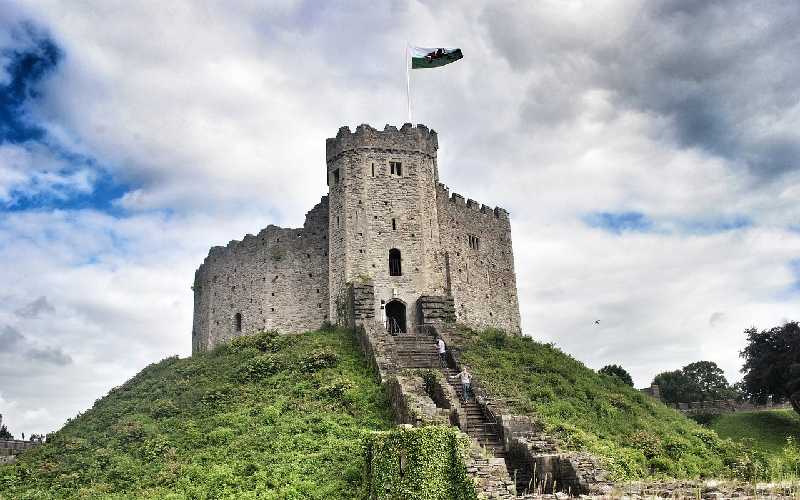Today we bring to you 10 of the best day trips from Bristol including Cardiff, Bath and Stratford Upon Avon. Most of these destinations are accessible by train from Bristol Temple Meads train station.
Day Trips from Bristol
Shipston-on-Stour and its Castle
One of the easiest and closest day trips from Bristol is probably the castle town of Shipston on Stour.
The castle stands on a rocky eminence, conical in shape, which rises about 180 feet (55 metres) above the town and gives commanding views over the surrounding countryside; it is some 200 yards from the centre of Shipston. The church of St. Andrew stands beneath the castle and dominates the scene; it is an impressive Perpendicular building, with a richly decorated tower containing ten bells.
At the foot of the hill on which the castle stands there runs at right angles to it a shallow stream or moat, with high banks, and below this is the main shopping street. The castle, which was built in the 13 th century at the centre of a royal manor, has had a varied history, having been the property of Richard Neville, earl of Warwick (the King maker), and owned by Oliver Cromwell’s cousin. More recently it had been used as a ‘lunatic asylum’.
In 1836 the main castle was in ruins; some years later it was converted to a private house, and then passed into other hands again. In 1941 it was badly damaged by fire during the blitz following Bristol ‘s heavy bombing, but has since been restored and is now occupied by an artist.
However, the castle still stands in the grounds and is an interesting example of mediaeval architecture. It was made by Edward III in 1354 for Ralph Neville, and consisted originally of a keep containing chambers on three storeys; later the walls were heightened and battlements constructed to provide new rooms in the roof.
The Castle is now privately owned but can be seen from the outside and the adjacent ruins of St. Katherine’s Chapel are now part of a country park in which there is also an old folly, formerly a gatehouse to the castle. The chapel contains a marble lectern given by Sir Walter Raleigh and it was here that he preached on Palm Sunday 1615 .
Cardiff

Cardiff Castle, which sits on the city’s southern outskirts, was built in 1091 by Robert Fitzhamon. It is he who gave Cardiff its original name of either Kaerdin or Caerdydd, meaning ‘Fortified Place’. In Norman times there were many castles in Wales and it is thought that more land changed hands as a result of the building of a castle than in any other way. Over the centuries, Cardiff Castle was extended and adapted and today is open to the public, although it has been placed on English Heritage’s Buildings at Risk register because of its poor condition.
Cardiff bay itself is a spectacular area with many fine buildings such as the Wales Millennium Centre and the new Senedd , home to the National Assembly for Wales, which is housed in a building fashioned from glass and steel.
At its heart is Cardiff Bay Barrage which was built between 1996 and 1999 . It contains 100,000 tonnes of concrete and 1.6 million bricks; it has 104 tunnelling machines, the largest of which weighs 1,000 tonnes and is twenty-five metres long; it takes thirteen years to pay off the interest on its cost.
Bath
One of the most popular day trips from Bristol has to be the Roman city of Bath.
The Roman settlement of Aquae Sulis is said to have been on the line of the present Pulteney Bridge, and tradition has it that the waters came bubbling up from beneath a boulder in the nearby river which was considered to be sacred. The town seems always to have had its fair share of newcomers, who were to make it famous and fashionable.
The Romans gave it its name, set up baths, laid out a street plan and, as in London , established a forum where markets were held. The town became an important garrison under the Saxons, who took over the administration of Britain from Rome . But like so many Roman towns Bath was deserted after the departure of the Romans, and it wasn’t until the 6 th century that it became a place of importance again, this time under the Saxon king, Ina. From then onwards Bath grew in prosperity and size; its health-giving waters attracted many visitors and they made it famous throughout Britain .
In 927 , Ethelstan, King of Wessex gave Bath to the monks of Winchester , and eventually it was made a bishopric. In 1245 Henry III enlarged the abbey, diverting the River Avon from its course on one side of it, in order to enclose within its precincts an area for which he had obtained a charter to hold a weekly market and an annual fair.
In the 16 th century the abbey fell into disrepair, but in 1860 it was restored by William Butterfield; this is one of his most successful works and has been described as a ‘magnificent Renaissance church’. Today Bath Abbey provides a fine setting for choral services on Sundays. In the abbey precincts is the statue of John Howard, who was born here in 1726 and went on to become a ‘prison reformer’.
The Royal Crescent is perhaps the most famous building in Bath . It was built soon after 1767 , when a local doctor, Richard Pococke, published an account of his travels abroad which contained some mildly satirical remarks about the poverty of contemporary architecture in England . This led to a revival of interest in classical design, and from 1771 until his death in 1791 Thomas Baldwin was engaged on this building, which is described by Pevsner as ‘the result of one man’s imagination rather than an attempt at copying any particular piece of antiquity’.
Salisbury
Salisbury is an ancient city, mentioned in the Domesday Book of 1086 . It was held by William the Conqueror and later passed into the hands of William’s half-brother, Bishop Osmund. The principal building in Salisbury is its magnificent cathedral , built between 1220 and 1319 ; for many years it was the tallest building in Britain , but this was only because at that time the spire of Lincoln Cathedral had not yet been built. If it were complete, Salisbury Cathedral would be the second largest church in Britain after St Paul’s. In 1220 a fire destroyed much of what had been built, so in 1220 Bishop Poore decided to rebuild it. The new cathedral was built in the Early English style in local sandstone, but by 1258 it had once again been burnt down – this time by accident. It took another 134 years to build again and was finally completed in 1365 . Salisbury contains many other fine buildings such as Greyfriars church (c. 1289 ) and the Bishop’s Palace (c. 1229 ).
Weston Supermare
Weston is located in the heart of Somerset, close to Bristol and Bath. The name Weston comes from ‘West Town’ and was originally referred to a medieval hamlet which still exists today, although it has no official status. Its history goes back at least as far as Saxon times when King Ine of Wessex gave it to Aethelmaer, a nobleman who fought alongside him in battle. It’s one of my favourite day trips from Bristol due to the beach!
Stroud
About fifteen miles north of Weston is Stroud, which has been called the ‘garden city’ because it was founded as a place where those working with textiles could live and so escape the pollution caused by their work. Today Stroud is famous for its fresh air, beautiful scenery and market gardening, but also for Stroud Brewery which produces the Hobgoblin brand of beer.
Stratford-upon-Avon
The small town of Stratford upon Avon was the home of William Shakespeare. A centre for tourism, it attracts many visitors, especially to its annual celebrations of Shakespearean plays. Nearby are Anne Hathaway’s cottage and royal residence of Clopton House .
Shakespeare’s house, which is now known as Anne Hathaway’s Cottage, stands next to the church where he was buried. It has been restored with timber framing and a thatched roof.
Stonehenge

Stonehenge was built in the stone age, around 3000 BC , although some of the stones may be older than that. They were quarried 200 kilometres away and then carried to Stonehenge on sledges pulled by animals, possibly woolly mammoths. This is quite an undertaking for people who had no wheeled vehicles or metal tools. Stonehenge is one of the best known monuments in the world and it has been suggested that it was built as a place of worship because some believe that the stones represent the sun. However, recent scientific evidence suggests that they show alignment with other stone circles and wooden posts and may have been used to help calibrate time .
Oxford
Oxford University was established in 1167 . As a small town, it has suffered from the plague and fires several times. The present university is made up of twenty-nine colleges, such as New College (founded 1379 ) and Merton College (1264 ). Most of these were founded during the Middle Ages, but two – Balliol College (1263) and Queen’s College (1341) – were established during the reign of Henry III . The university had a long connection with Thomas Becket . Archbishop of Canterbury between 1162 and 1170 , in 1265 he built Christ Church Cathedral next to one of the colleges, which is still used by the college today. His successor, John Peckham , also became chancellor of the university. In 1380 he was killed by a mob which charged into his house and beheaded him at the bridge over the River Cherwell.
Gloucester
Gloucester was founded in the Roman era, when it was called Glevum. Around 50BC the Romans enclosed it with a defensive wall and built a market place outside the town walls, which became known as the forum . In medieval times Gloucester grew rapidly, especially under Henry I who improved trade by making it one of England ‘s four staple towns. Gloucester has many fine medieval buildings, such as the magnificent abbey church of St Peter and Paul (1175), where King Henry VII was buried. Another important building in Gloucester is the Guildhall which was built in 1491 by Thomas Horne.
We hope that you have enjoyed these fabulous day trips from Bristol. If you have idea more ideas for Bristol day trips please leave a comment on our blog below – we’d love to hear from you!

1 thought on “10 Fabulous Day Trips from Bristol”